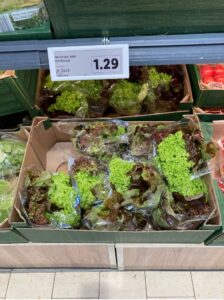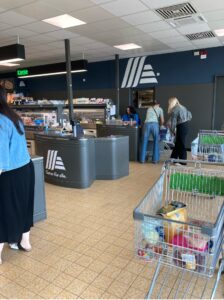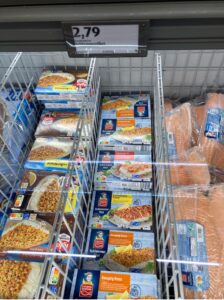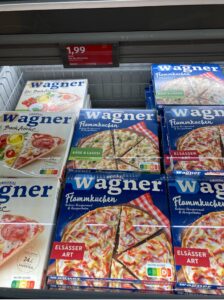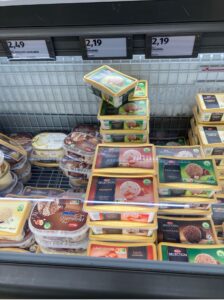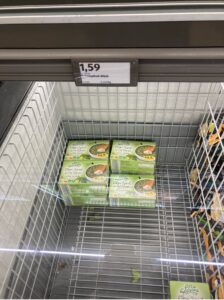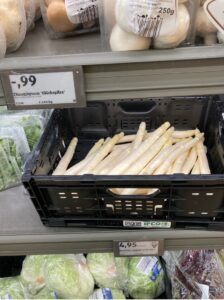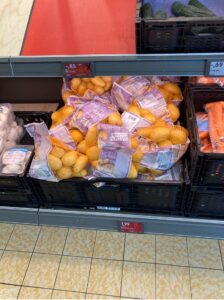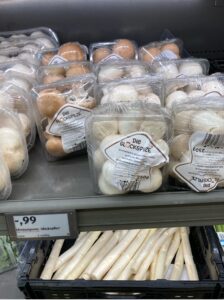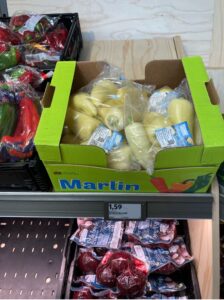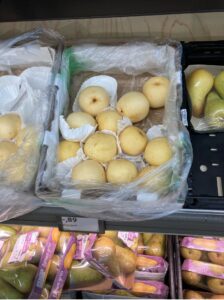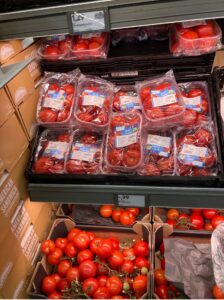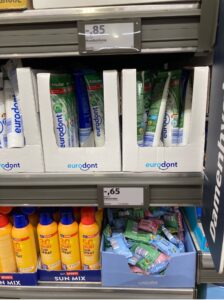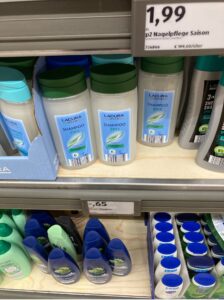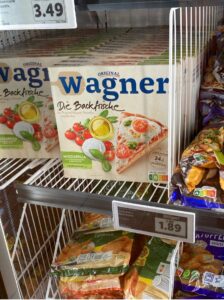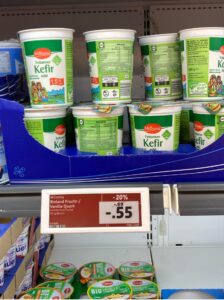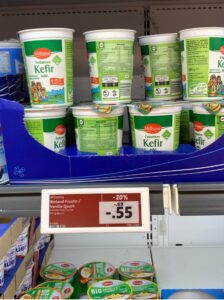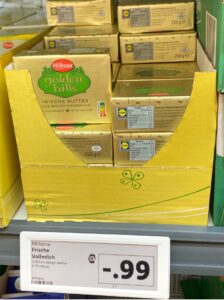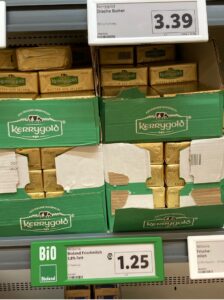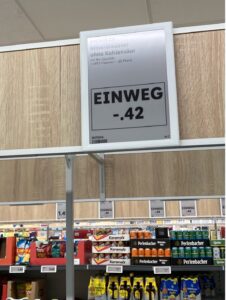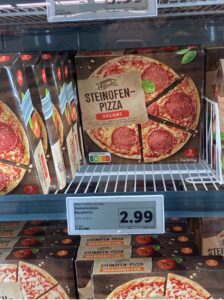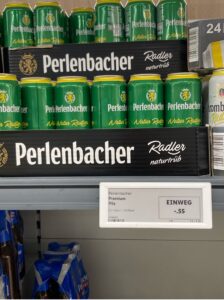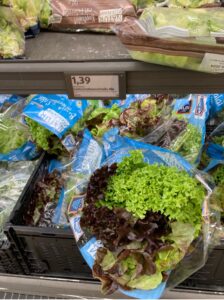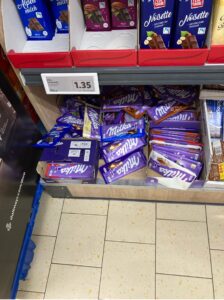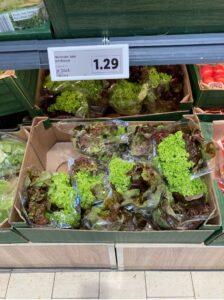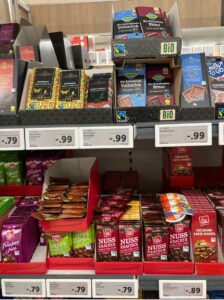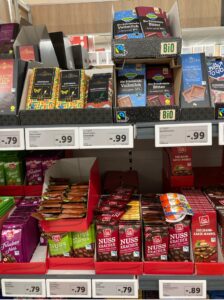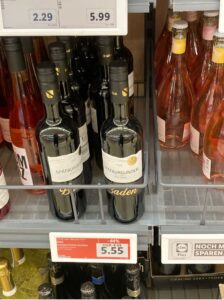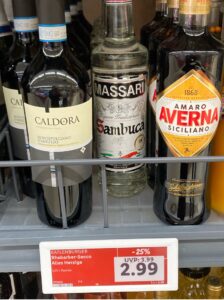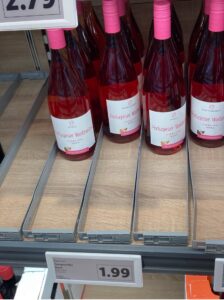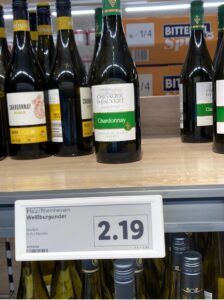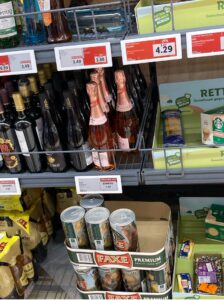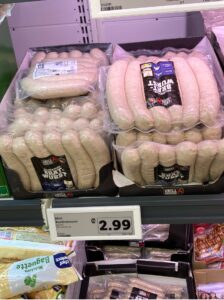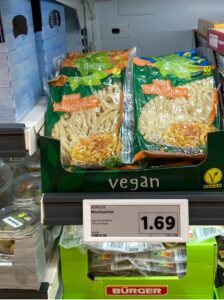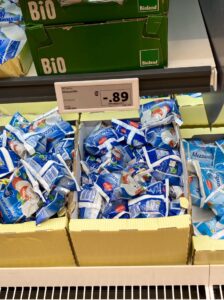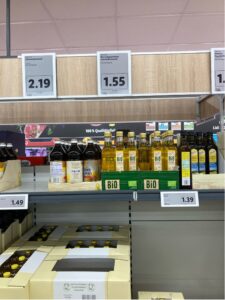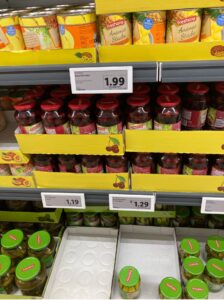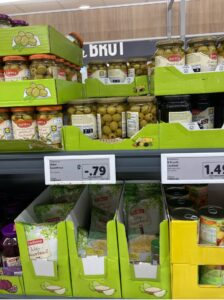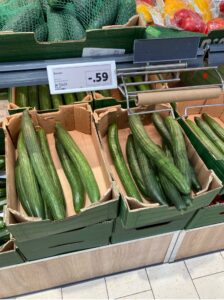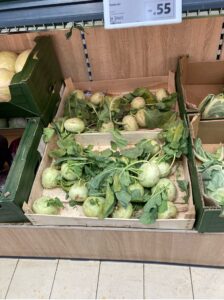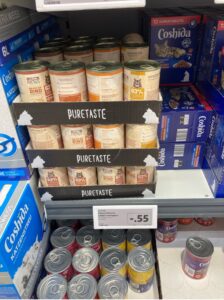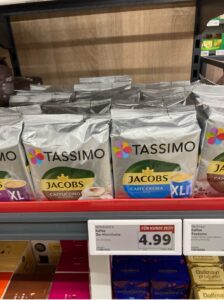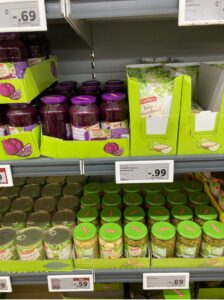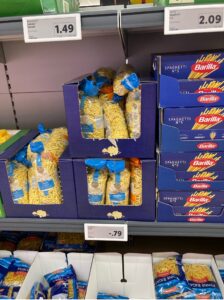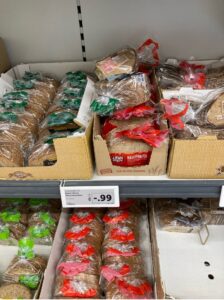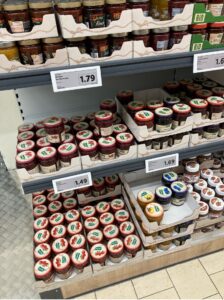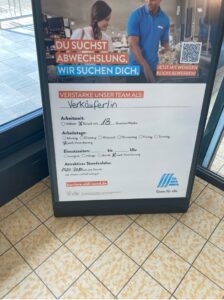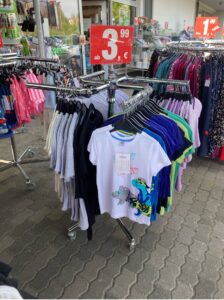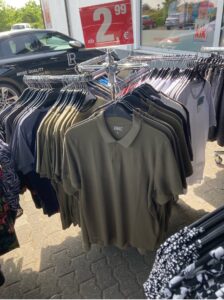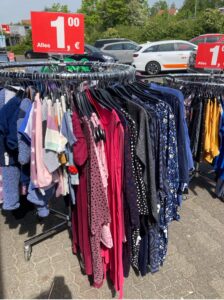Took photos of prices and groceries, posted in the enclosed link. I went to Aldi in Bingen, Germany today and took the photos.
All prices are in Euro. The Euro right now is 1 Euro to 1.07 US dollars, a 1:1.07 exchange ratio, pretty much the same amount when converted. The quantities are shown either in grams or in kilos. One kilogram is 2.2 American pounds. You can do the simple price conversion/size math and comparison from there.
Below are groceries from Lidl and Aldi, 2 biggest grocery stores here. These are grocery store prices. Europe is full of specialty grocery merchants – individual bakeries, butcher shops, endless farmers’ markets that are all usually fresher and even cheaper and higher in quality than these grocery store prices. In addition, this region of Germany shops directly from family farms. Call the farmer and order your fresh organic produce, homemade meat, cheese and other products for even better prices and fresher foods. Here is what it looks in price comparison in the EU.
Welcome to Aldi in Germany. They are sitting down and comfortable at the cash register in the whole country. Aldi imported this concept to the US also. The shopping carts are also coin-operated, ensuring that all the personnel to catch shopping carts in the parking lot or carry it out for customers are not required, one of many ways of keeping food cost lower.
Various frozen breaded fish fillets, feeds 4 for 2.79 Euro
Flammkuchen a.k.a. “Tarte” is a pizza-like meal with leeks, cheese, smoked meats, etc. that comes from France. Feeds 2 people for under $2.
Ice cream, same family-sized containers as in the US for 2.19 to 2.49 Euro.
Premium fair trade organic Colombian coffee, 600 grams
Huge box of creamy spinach in individual portions, close to 2 pounds, for 1.59
Here is a specialty of Germany, currently in season. German asparagus is huge but more tender than American asparagus and far more flavorful and is always creamy white. 2.2 US pounds cost 4.95. The 99 cents price tag refers to the big Champignon mushroom packages to the left.
2.99 for a 5-pound bag of potatoes. Above it, 69 cents for cucumbers
Mushrooms, both Champignon and Portabella for 99 cents for 250 grams
Big sweet salad and stuffing peppers. This variety is used instead of bell peppers but these big long pointed Italian peppers are far tastier than the fairly flavorless bell peppers. Half a kilogram for 1.59
Hosui pears for 89 cents each. These are stupid expensive in the US if one can find them
Ripe Roma tomatoes for 1.29 per sixpack or loose ones for 99 cents per kilo (2.2 US pounds)
Standard-sized toothpaste for 85 cents
Acceptably mild generic OK in basic quality shampoo costs 65 cents per bottle. The 1.99 price refers to nail polish on the shelf above it
Frozen pizza for people for 1.89. Frozen pizza tastes like cardboard in Europe, too, but look at this regular price for what can be a whole dinner for under $2
Kefir, 500 grams, more than 1 pound for 55 cents. Kefir (cultured sour milk, generally healthier in beneficial cultures than yoghurt) is scarce and expensive in the US
Soy milk, 1 liter for 85 cents
Premium quality Irish butter from organic cows on pastures for 99 cents for just under half a pound. One liter of milk for 99 cents
Since many Americans are familiar with this brand, Kerrygold butter is 1.25 for a half pound block
Fizzy mineral water for 42 cents per liter. Individual German beer cans for 49 cents each for tall aluminum cans
Pizza for 2 for 2.99
Gerolsteiner mineral water comes from deep mineral wells from the town of Gerolstein in this immediate area in Germany. One liter of Gerolsteiner fizzy water is 49 cents here
Good quality German beer in tall glass bottles, 6 bottles for 2.69. Of this price, 25 cents are refunded per bottle if it is returned for recycling, so the net price of this sixpack is 1.19 after returning the empty bottles for the whole sixpack. Where in the US can we find a sixpack of German beer for 1.19? Even the cheapest German beer is better than watery American beer. Germany is one of the beer capitals of the world
Medium quality German beer for 55 cents per can, 25 of which is refundable if you bring the empty bottles back, so this name brand Pilsner beer is actually 30 cents per tall can
Fresh organic lettuce, 3 whole heads in 1 bag for 1.39
Unbleached environmental toilet paper 2.45 for 10 rolls, decent medium quality
Various brands of chocolate, full sized bars, all around one dollar in USD
One of the more expensive wines, a dry late Burgundy, quite good in quality, 1 liter for 5.99. That is about as high as the fancier wines get here
Italian wine for 2.99. Italian wine has the lowest histamine count of any wine in the world, making it suitable for people who have histamine reactions and cannot otherwise drink wine without getting ill. The same goes for the young red Burgundy wines in this part of Germany. I cannot find such an equivalent in the US because I have histamine reaxtions to most American wines, mainly because they are unregulated in histamine content
Portuguese rose wine for 1.99. Sweet rose wine is not my thing but this is a popular brand most people like
Chardonnay from France for 2.19. France is one hour from here
Various Proseccos and rose wine for 3.88 Euro. The originally 6.99 wine next to it is a higher end brand and currently on sale for 3.49, about as expensive as wine gets in Germany. Note, this area is also the main wine country of Germany
Whole lotta Bratwurst for 2.99. The baguettes under it are 99 cents
Fresh German Spaetzle for 1.69 for 2 people
Fresh Mozzarella balls for 89 cents for 200 grams (almost half a US pound)
Fairtrade organic bananas, 2.2 pounds for 1.99. Not cheap but good price for fairtrade organic import from Ecuador
Organic specialty honey for 1.05 to 1.49 per 200 grams
Sunflower Oil 1 liter, various brands ranging from 1.55 to 2.19 per liter
Tart cherries 1.29 for a big jar, pineapple for 1.99. Price above is for a large can of pineapple chunks. European fruit has only sugar, no high-fructose corn syrup. Same goes for jams and jellies and other sweet items
Sauerkraut, Greek olives, etc. 1-1.45 Euro each
European salad cucumbers 59 cents each
Fresh kohlrabi 55 cents each. These are excellent steamed. Cook one per person with butter and salt
XL-sized catfood cans 55 cents each, good quality
Refrigerated fresh pasta 1.19, olives 1.49
Rapeseed Oil, 1 liter for 1.39. Rapeseed oil is Europe’s equivalent of American Canola oil, an inexpensive all-purpose frying oil but unlike Canola, this stuff is organic, not GMO corn-soy mixed hydrogenated artery clogger. I know people who converted their cars to run on rapeseed oil in Germany because it is much cheaper than German gasoline and the oil is widely available everywhere for this price
Rapeseed Oil and big inexpensive sunflower oil bottles
Pasta 79 cents up to 2.09 for the big multipacks
Bread is serious business in Germany, one of the best breadmaking countries in the world. The bread comes from a real bakery in the town and is excellent. For 99 cents to 2 Euro, one can buy any bread in Germany
Preserves, jams and jellies, 1-2 Euro per glass jar. No high-fructose in Germany, all fruit and sugar. European jams are far superior to American ones in quality and taste
The same Aldi store advertises for sales persons age 18 and above for a starting salary of 15.57 to 20+ an hour. It is completely possible with much lower cost of living in the EU to actually live on even a $20 an hour part-time job if they are frugal, definitely easy if this job is full-time and comes with full benefits. Compare that to young people’s income in the US and what they can buy with their earnings. Nobody in the EU needs to be unhoused, hungry or without medical care because there are lots of laws protecting workers and securing income, healthcare, etc.
TRAVEL
Travel in Europe by train is a pleasant experience. The trains are roomy and a friendly person, much like a US flight attendant, comes through with a cart with good fresh food and endless wine. Get an inexpensive bottle of wine and watch the landscapes roll by. Check EU trains as they have constant package prices for small money.
Here is airfare. For intra-EU travel and Europe to North Africa, Ryanair is generally the cheapest carrier. They are out of Ireland and operate a bare bones flight. One carry-on is allowed but all baggage costs extra. The way to do this is to use a backpack or big carry-on. Advertised in the link below is a host of flights from one major city in Europe to another starting at $35. The prices are real. I traveled Ryanair from London to Frankfurt for $49 last time. There are occasionally even $1 tickets connecting European cities. How does that work? The carrier gives away the tickets for 1 Euro and makes a few dollars extra in airport tax which the carrier would otherwise pay for empty seats. Giving away flights for a few dollars last minute still pays for them because the unsold seats prevent the carrier from making net losses for such airport fees. Here is RYANAIR. Check all their flights and prices.
GAS STATION
Here is the gas station that is in the same mall. Prices enclosed. One US gallon is 3.6 liters and these are liter prices. Do the math. Diesel is 1.59 for 1 liter which translates to $5.72 per gallon. Diesel is always the cheapest fuel in the EU.
Gas is one of the few things that are more expensive in Europe. Europe is full of tiny cars that consume little, so this is doable, even if pricey. Europe is also full of so much cheap public transportation such as a fabulous train grid connecting everything to pretty much everything else, so that a car is actually entirely optional, ensuring that people on a low budget are not forced to pay steep gas prices.
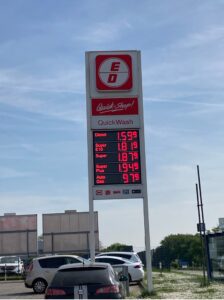
CLOTHING
This is a phenomenon all over Germany. Cheap clothing on the sidewalk. Some child textile slaves in Bangladesh may be suffering for this but here it is just to show that acceptable quality new clothing is available everywhere for $1 on up. These are normal prices in bargain stores, not a special sale. We don’t know how this is possible but these prices are a common sight.
Name brand German Birkenstock shoes in the same mini mall from $70 on up.
New shirts and dresses for 1 Euro ($1.07) by the hundreds for this price
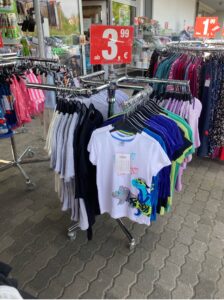
None of these items are high-end in the EU but all are of good quality. This is what the average budget grocery expense looks like. The top quality groceries in Europe are often on family farms, farmers’ markets (those are fabulous in Europe!) and in specialty stores. This post represents average grocery store prices with photos snapped randomly throughout the grocery store.
This post does not intend to show anyone fine dining in Europe but instead everyday working class prices. Note that these stores are under EU law which requires them to pay every high school kid at least $15-20 per hour plus benefits. People survive just fine on this. That is the point of this post. If Europe can still maintain this cost of food, why exactly can’t the4 US feed its citizenry at affordable prices?
Share now


